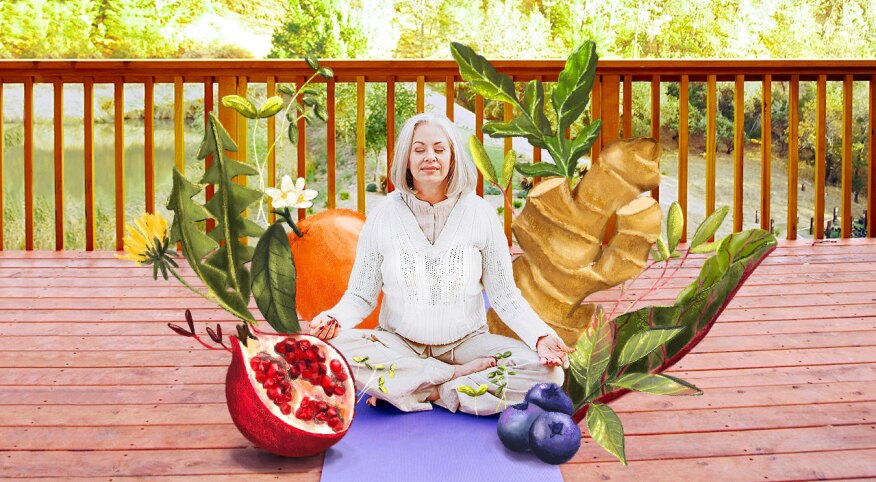Want to connect with other older women and make new friends? Join our Ethel Circle closed Facebook group today!
In 1996, I was 32 years old, making my way to a meditation center in Southern England. As the taxi drove me from the train station toward the village, I made note of the cafes and bakeries where I might escape to for a scone with strawberry jam and clotted cream, a pastry or a piece of pie.
I was on my way to a 10-day silent retreat and kept the sweets in the back of my mind in case I craved them. I was certain the food would be bland and not plentiful at the retreat center.
Ever hopeful I could eat a bit more than my share, even if it wasn’t great, I volunteered to work in the kitchen as my “yogi job”. But the unexpected happened. The magic of making the food, in silence, with reverence and love, began a slow, subtle, lifelong change in my relationship with eating. The meals were delicious. Truly farm-to-table, they included fresh vegetarian food bursting with flavor.
Along with meditating 10 hours a day, preparing the food and eating with 30 other people, I began healing my mind and body. Ever since that retreat, food and meditation have been inextricably linked for me.
Food had been my comfort, my protector, in good times and bad, boredom and excitement, happiness and sadness. I had not yet learned that all eating is emotional eating and that diets don’t address the mind. I easily weighed over 210 pounds at that time, and while I was not attending the retreat to lose weight, it became clearer during meditation why I ate too much, and my behavior changed.
This power of mindfulness, with eating and all essential areas of life, is the foundation that spawned my long career as a meditation teacher and meditation/mindfulness retreat leader. The wholesome meals we made decades ago at the center in England settled my mind, reducing the incessant chatter and making it easier to meditate. Because of this life change, I am now very intentional about what I eat.
I had been on various diets since I was 12 years old and I had no understanding of what healthy eating was all about. Sugar gave me bursts of energy, and soon after dragged me down to inertia. Carbs fed my cravings but left me heavy and drained. It felt like my mind was playing tricks on me. Eat this and you’ll feel better, only to be let down — and to gain weight — over and over again.
My story of disordered eating and healing came from meditation masters in the kitchen and learning that food is medicine that heals. So much of what I practice and teach is based on my early days, chopping carrots and cabbage in meditation center kitchens around the world — and eating simple and delicious meals.
Science has caught up with this too. Nutritional psychiatry is a new field of study. Researchers have found that meditation helps us to make better choices in our lives, including what to eat. And what we eat leads us not only to deeper, more profound mindfulness, it also promotes longevity.
Dr. Uma Naidoo is a Harvard-trained nutritional psychiatrist and biologist, professional chef and author of the bestseller This Is Your Brain on Food: An Indispensable Guide to the Surprising Foods that Fight Depression, Anxiety, PTSD, OCD, ADHD, and More.
I asked her how food affects us in the morning, as many people meditate first thing. She told me: “If someone consumes a carb-heavy breakfast such as a bagel or pastry, their brain will be flooded with glucose which can lead to hyperactivity followed by an energy crash, both of which make it difficult for one to concentrate.”
Instead, she recommends eating a “brain healthy breakfast such as chia seed pudding with a handful of blueberries that provide the body with fiber and healthy fats.” While Dr. Naidoo drinks only water before meditating, if you are a bit hungry before sitting, have a light snack, like a handful of almonds or a piece of fruit.
After 30 years of meditation, I know that what science is finding is true, beyond transforming our relationship with food. According to many studies, including research at NIH’s National Center for Complementary and Integrative Health, a regular meditation routine can help increase focus and concentration. It can also help you sleep better, reduce anxiety and depression, and help you experience a deeper sense of happiness and well-being. Just sitting quietly for 10 to 20 minutes in the morning, allowing thoughts to flow out with your breath, can elevate and enhance your whole day.
Eating well will only lift you up more! Because of decades of mindful meals, I now am acutely aware of when I am full and that it’s time to push the plate away!
Brain foods for calming the mind may include:
· Omega 3 fatty acids found in fatty fish, nuts and seeds
· Spices like turmeric with a pinch of black pepper
· Leafy greens like spinach, Swiss chard and dandelion greens
· Fermented foods that include plain yogurt, kimchi, sauerkraut and miso
Do any of you practice meditation? Let us know in the comments below.

Kate Wong (Stocksy)
Follow Article Topics: Health





